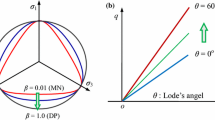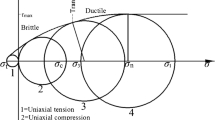Abstract
The paper describes a continuum, rate-independent, incremental plasticity constitutive model applicable in weak rocks and heavily fractured rockmasses, where mechanical behaviour is controlled by rockmass strength rather than structural features (discontinuities). The model describes rockmass structure by a generalised Hoek–Brown Structure Envelope (SE) in the stress space. Stress paths inside the SE are nonlinear and irreversible to better simulate behaviour at strains up to peak strength and under stress reversals. Stress paths on the SE have user-controlled volume dilatancy (gradually reducing to zero at large shear strains) and can model post-peak strain softening of brittle rockmasses via a structure degradation (damage) mechanism triggered by accumulated plastic shear strains. As the SE may strain harden with plastic strains, ductile behaviour can also be modelled. The model was implemented in the Finite Element Code Simulia ABAQUS and was applied in plane strain (2D) excavation of a cylindrical cavity (tunnel) to predict convergence-confinement curves. It is shown that small-strain nonlinearity, variable volume dilatancy and post-peak hardening/softening strongly affect the predicted curves, resulting in corresponding differences of lining pressures in real tunnel excavations.








Similar content being viewed by others
Abbreviations
- SDR:
-
Constitutive model for Strength Degradation of Rockmasses
- SE:
-
Structure Envelope
- SPR:
-
Stress Path Reversal
- SSR:
-
Stress Sign Reversal
- a, σ c, m b, s :
-
Genearlised Hoek–Brown parameters
- b :
-
Rotation of the SE axis o with respect to the isotropic (σ) axis
- \({\mathbf{C}}^{e}\) :
-
Tangent non-plastic stiffness matrix
- c :
-
Primary strength anisotropy parameter varied along each of the five shearing directions (values c 1 , c 2 , … c 5 along deviatoric axes S 1 , S 2 , … S 5)
- d :
-
State variable controlling the tensile strength of the rockmass, d = (s/m b ) σ c
- d in, d fin :
-
Initial and final values of structure variable d
- H :
-
Plastic hardening modulus
- I :
-
Unit isotopic tensor
- K, G :
-
Nonlinear bulk and shear moduli
- m b,in, m b,fin :
-
Initial and final values of structure variable m b
- n :
-
Material constant controlling the non-plastic stiffness mean stress dependency
- P :
-
Plastic potential tensor
- P, P′:
-
Volumetric plastic potential and plastic potential deviator
- p atm :
-
Atmospheric pressure (p atm ≅ 101.3 kPa)
- Q :
-
Gradient of the SE
- Q, Q′:
-
Isotropic and deviatoric components of gradient Q
- q :
-
Scalar stress deviator (shear stress)
- r :
-
Radial distance along the springline measuring from the tunnel centre (r ≥ R, where R is the tunnel diameter)
- \(\varvec{s}\) :
-
Stress deviator
- u R :
-
Wall tunnel convergence
- u r :
-
Radial convergence along the springline
- \(\dot{W}\) :
-
Second-order total work
- \(\dot{W}^{p}\) :
-
Second-order plastic work
- γ :
-
Material constant controlling the rate of stiffness reduction
- \(\dot{\varvec{\varepsilon }}\) :
-
Strain increment
- \(\dot{\varepsilon }\,,\;\dot{\varvec{e}}\) :
-
Volumetric strain and strain deviator increments
- \(\dot{\varvec{\varepsilon }}^{e}\) :
-
Non-plastic strain increment
- \(\dot{\varepsilon }^{e} \,,\;\dot{\varvec{e}}^{e}\) :
-
Non-plastic volumetric strain and strain deviator increments
- \(\dot{\varvec{\varepsilon }}^{p}\) :
-
Plastic strain increment
- \(\dot{\varepsilon }^{p} \,,\;\dot{\varvec{e}}^{p}\) :
-
Plastic volumetric strain and strain deviator increments
- \(\varepsilon_{\text{a}}\) :
-
Axial strain
- \(\varepsilon_{q}^{p}\) :
-
Scalar deviatoric plastic strain
- \(\dot{\varepsilon }_{q}^{p}\) :
-
Scalar deviatoric plastic strain increment
- \(\varepsilon_{{q,f_{1} }}^{p}\) :
-
Material constant equal to the accumulated plastic shear strain when variable m b reaches the final value (m b,fin)
- \(\varepsilon_{{q,f_{2} }}^{p}\) :
-
Material constant equal to the accumulated plastic shear strain when variable d reaches the final value (d fin)
- \(\varepsilon_{\text{vol}}\) :
-
Volumetric strain
- ζ, n pq :
-
Material constants controlling plastic volume dilatancy
- θ in, θ fin :
-
Initial and final values of variable θ
- \(\dot{\varLambda }\) :
-
Scalar plastic multiplier
- ν :
-
Poisson’s ratio
- ξ, θ :
-
State variables controlling the volumetric and deviatoric stiffness nonlinearity and irreversibility along non-plastic paths
- ξ in, ξ fin :
-
Initial and final values of variable ξ
- ξ 0, θ 0 :
-
Values of variable ξ and θ at the SE axis
- ξ SSR, θ SSR :
-
Values of variable ξ and θ at SSR
- \(\varvec{\sigma}\) :
-
Stress tensor
- \(\sigma\), p :
-
Mean stress
- \(\dot{\varvec{\sigma }}\) :
-
Stress increment
- \(\dot{\sigma }\,,\;\dot{\varvec{s}}\) :
-
Mean stress and stress deviator increments
- σ 1, σ 2, σ 3 :
-
Major, intermediate and minor principal stresses
- σ rev :
-
Stress at SPR
- σ SSR :
-
Stress at SSR
References
Al-Ajmi AM, Zimmerman RW (2005) Relation between the Mogi and the Coulomb failure criteria. Int J Rock Mech Min Sci 42:431–439
Alejano L, Alonso E (2005) Considerations of the dilatancy angle in rocks and rock masses. Int J Rock Mech Min Sci 42:481–507
Alejano L, Garcia Bastante F, Alonso E, Taboada J (1999) Back analysis of a rock-burst in a shallow room and pillar gypsum exploitation. In: 9th ISRM congress, Paris, pp 1077–1080
Chang C, Haimson B (2000) True triaxial strength and deformability of the German Continental Deep Drilling Program (KTB) deep hole amphibolite. J Geophys Res Solid Earth 105:18999–19013
Crouch S (1970) Experimental determination of volumetric strains in failed rock. Int J Rock Mech Min Sci Geomech Abstr 7(6):589–603
Detournay E (1986) Elastoplastic model of a deep tunnel for a rock with variable dilatancy. Rock Mech Rock Eng 19:99–108
Filimonov YL, Lavrov AV, Shafarenko YM, Shkuratnik VL (2001) Memory effects in rock salt under triaxial stress state and their use for stress measurement in a rock mass. Rock Mech Rock Eng 34:275–291
Frantziskonis G, Desai C (1988) Constitutive model with strain softening. Math Comput Model 10:794
Gerogiannopoulos N, Brown E (1978) The critical state concept applied to rock. Int J Rock Mech Min Sci Geomech Abstr 15(1):1–10
Hill R (1958) A general theory of uniqueness and stability in elastic-plastic solids. J Mech Phys Solids 6:236–249
Hoek E (1983) Strength of jointed rock masses. Geotechnique 33:187–223
Hoek E, Brown ET (1980) Empirical strength criterion for rock masses. J Geotech Eng Div 106(9):1013–1035
Hoek E, Brown E (1997) Practical estimates of rock mass strength. Int J Rock Mech Min Sci 34:1165–1186
Hoek E, Diederichs M (2006) Empirical estimation of rock mass modulus. Int J Rock Mech Min Sci 43:203–215
Hoek E, Wood D, Shah S (1992) A modified Hoek–Brown criterion for jointed rock masses. In: Proceedings of the rock characterization, symposium on international society of rock mechanics: Eurock, pp 209–214
Hoek E, Kaiser P, Bawden W (1995) Support of underground excavations in hard rock. AA Balkema, Rotterdam
Hoek E, Carranza-Torres C, Corkum B (2002) Hoek–Brown failure criterion-2002 edition. In: Proceedings of NARMS-TAC, pp 267–273
Kavvadas M, Amorosi A (2000) A constitutive model for structured soils. Geotechnique 50:263–273
Kudoh K, Koyama T, Nambu S, Suzuki Y, Ishibashi K (1999) Support design of a large underground cavern considering strain-softening of rock. In: 9th ISRM congress, International Society for Rock Mechanics
Ma L-J, Liu X-Y, Wang M-Y, Xu H-F, Hua R-P, Fan P-X, Jiang S-R, Wang G-A, Yi Q-K (2013) Experimental investigation of the mechanical properties of rock salt under triaxial cyclic loading. Int J Rock Mech Min Sci 62:34–41
Mandel J (1966) Conditions de stabilité et postulat de Drucker. In: Rheology and Soil Mechanics/Rhéologie et Mécanique des Sols, Springer
Mas Ivars DM, Pierce ME, Darcel C, Reyes-Montes J, Potyondy DO, Paul Young R, Cundall PA (2011) The synthetic rock mass approach for jointed rock mass modelling. Int J Rock Mech Min Sci 48:219–244
Medhurst T, Brown E (1998) A study of the mechanical behaviour of coal for pillar design. Int J Rock Mech Min Sci 35:1087–1105
Mogi K (1971) Fracture and flow of rocks under high triaxial compression. J Geophys Res 76:1255–1269
Mroz Z (1963) Non-associated flow laws in plasticity. J Mécanique 2:21–42
Pan X, Hudson J (1988) A simplified three dimensional Hoek–Brown yield criterion. In: ISRM international symposium, International Society for Rock Mechanics
Priest S (2005) Determination of shear strength and three-dimensional yield strength for the Hoek–Brown criterion. Rock Mech Rock Eng 38:299–327
Ribacchi R (2000) Mechanical tests on pervasively jointed rock material: insight into rock mass behaviour. Rock Mech Rock Eng 33:243–266
Wang R, Kemeny J (1995) A new empirical failure criterion for rock under polyaxial compressive stresses. In: The 35th US symposium on rock mechanics (USRMS), American Rock Mechanics Association
Wang Z-L, Li Y-C, Wang J (2007) A damage-softening statistical constitutive model considering rock residual strength. Comput Geosci 33:1–9
Wang S, Zheng H, Li C, Ge X (2011) A finite element implementation of strain-softening rock mass. Int J Rock Mech Min Sci 48:67–76
Yoshinaka R, Osada M, Tran TV (1996) Deformation behaviour of soft rocks during consolidated-undrained cyclic triaxial testing. Int J Rock Mech Min Sci Geomech Abstr 33:557–572
Yuan S-C, Harrison J (2004) An empirical dilatancy index for the dilatant deformation of rock. Int J Rock Mech Min Sci 41:679–686
Acknowledgements
The present research has received partial funding from the European (FP7) project New Technologies for Tunnelling and Underground works (NeTTUN) under Grant Agreement 280712.
Author information
Authors and Affiliations
Corresponding author
Rights and permissions
About this article
Cite this article
Kalos, A., Kavvadas, M. A Constitutive Model for Strain-Controlled Strength Degradation of Rockmasses (SDR). Rock Mech Rock Eng 50, 2973–2984 (2017). https://doi.org/10.1007/s00603-017-1288-x
Received:
Accepted:
Published:
Issue Date:
DOI: https://doi.org/10.1007/s00603-017-1288-x




